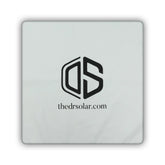Window Tint 101: What It Is, How It Works & Why It Matters
Window Tint 101: What It Is and Why It Matters
Whether you're driving through the summer sun or sitting by your favorite window at home, window tint plays a bigger role than you might think.
At Dr. Solar, we specialize in high-performance films that block heat, filter UV rays, and keep your space cooler — all while looking great. But if you're just starting your window film journey, let’s cover the basics.

What Is Window Tint?
Window tint is a thin, multi-layered polyester film applied to glass surfaces. It can be clear, tinted, reflective, or even decorative — depending on its use. Most films have built-in technologies to reduce glare, heat, and harmful UV exposure.
It’s used on:
- 🚗 Car windows for heat rejection and UV protection
- 🏠 Residential windows for energy efficiency and privacy
- 🏢 Commercial glass for security, glare control, and branding
How Does Window Film Work?
Different types of window tint target different parts of the light spectrum:
- Visible Light: Controls glare and brightness
- Infrared (IR) Light: Reduces heat
- Ultraviolet (UV) Light: Blocks the rays that fade furniture and damage skin
Films are designed with optical clarity in mind — so even darker tints don’t necessarily mean lower visibility from the inside out.

Why Use Window Tint?
Here are the core benefits of window film, whether you're tinting a Tesla or treating a sunroom:
| Benefit | What It Does |
|---|---|
| ☀️ Heat Rejection | Reduces interior temperatures and AC use |
| 🛡️ UV Protection | Blocks up to 99% of harmful ultraviolet rays |
| 🪟 Privacy | Obscures views into your car or home from the outside |
| 👁️ Glare Reduction | Makes screens easier to see and drives more comfortable |
| 💎 Aesthetics | Enhances your home or car’s look with a sleek finish |
Types of Window Film
Not all window films are created equal. Here's a quick overview of common categories:
- Dyed Film: Budget-friendly and great for glare reduction
- Metallic Film: Reflects heat but may interfere with signals
- Carbon Film: Matte finish with strong heat rejection and no signal interference
- Nano Ceramic Film: Top-tier clarity and heat control with no metal
Coming soon: We'll cover these in detail in our next post in the series.
How to Choose the Right Tint
The best tint depends on your goals:
- 🌡️ Want a cooler car or house? Look for films with high IR rejection
- 🪞Need privacy? Choose a darker VLT (visible light transmission)
- 🎨 Want a subtle look? Consider light ceramic or carbon tints
Still not sure? Ask Dr. Solar — we’ll help you choose based on your glass, climate, and comfort level.

Ready to Explore?
Whether you're a DIYer or just curious, we've got you covered. Check out our:
Want to know which car window tint is best for your needs? Read our follow-up guide: Automotive Window Film Types Explained →























